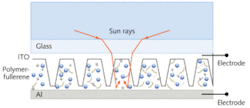Q-SWITCHED LASERS: Uses proliferate for high-energy picosecond UV lasers
High-energy, ultrashort-pulse ultraviolet lasers are useful for many practical applications—for example, fabrication of solar cells and flat-panel displays, 3-D information storage, cutting of thick sheets of material, photomask manufacturing, and remote sensing. However, the radiation from currently available femtosecond lasers cannot be easily converted into the ultraviolet (UV) because of self-focusing of the beam in nonlinear crystals. Only pulses of several picoseconds in length can be effectively converted to UV.
Conventional laser materials (such as Nd:YAG, YLF and YVO4 crystals, and Yb:YAG) having bandwidths of 5 to 10 cm-1 or more can amplify pulses that have an inverse linewidth corresponding to a few picoseconds or even shorter. But self-focusing prevents direct amplification, and so the vast majority of commercially available picosecond lasers have energy outputs of several millijoules or less.
Boosting the energy of such short pulses requires chirped-pulse amplification. We have developed a new double-pass nongrating stretcher-compressor for this purpose that has a relatively small clear aperture, is mechanically robust, and is relatively insensitive to optical misalignment. A double-pass laser amplifier and backward-reflecting mirror are located behind the device.
The resulting lasers can produce 5 to 8 ps UV pulses with fluences exceeding 1 J/cm2 and energies of 100 mJ at the fundamental wavelength. These pulses can be converted to the UV with 30% to 40% efficiency, which opens up new opportunities for micro- and nanomachining without the need for precise translation stages, beam-scanning devices, or other expensive parts.
Surface patterning and perforation
Picosecond UV pulses can be used to restructure metallic or dielectric surfaces. Different patterns can be formed depending on the fluence at the surface. When manufacturing organic photovoltaic thin-film solar cells, for example, a short laser pulse interacting with a surface can induce sub-wavelength periodic ripples stretched in the direction orthogonal to the laser polarization.1 The structuring, which increases solar-cell efficiency, can be achieved either by using a silicon mold formed by a laser pulse or via maskless direct laser forming of ripples on a dielectric surface (see Fig. 1).
A conductive indium tin oxide (ITO) thin film can be deposited on a glass substrate and the laser used to induce nanometer-width ripples. For dielectrics, the distance between ripples can be as small as λ/2n, where λ is the wavelength and n is the refractive index of the material.2 Solar rays passing through a transparent glass/ITO substrate are absorbed in the bulk heterojunction consisting of a polymer-fullerene mixture. The absorption of the sunlight excites electron-hole pairs; residual sun rays are reflected from the aluminum substrate and absorbed by the same material mixture.
On one hand, the small exciton diffusion length of organic semiconductors limits the photoactivity to a small volume of dimensions—about 30 to 40 nm, typical of the diffusion length of excitons in conjugated polymers. On the other hand, absorption of solar rays occurs over distances of several hundreds of nanometers.
A compromise can be realized if the laser-patterned ripples on the ITO surface have a period of about 80 nm and a depth of about 300 nm. To improve the mechanical properties of bulk heterojunctions and to avoid internal short circuits, a periodic insulator structure (with a period of several microns) can also be used. High-pulse-energy lasers could allow the manufacture of inexpensive solar cells with sizes of up to 10 mm. These cells could be combined to form larger panels at little additional cost.
Ultraviolet-laser perforation can also be used in the fabrication of flat-panel displays. This requires the creation of a set of tips (electron emitters) with surrounding wires, and subsequent trimming. The tips can be created by drilling of microholes in the surface of a mold. Similar tasks arise in the tooling required to manufacture printing devices, and in the automotive industry. In each of these cases, the targeting of the laser beam doesn’t require precise positioning if the beam can cover a relatively large area of processed material. High-pulse-energy lasers can reduce processing costs.
Laser processing of thick materials
A high pulse energy allows thick sheets of metal, glass, ceramics, and plastics to be cut with a minimum of runoff material because of the narrow area of laser processing. Laser ablation requires a certain fluence E (in the UV range of 5 to 30 J/cm2, depending on material). Increasing the UV pulse energy widens the optimal beam diameter d, and provides a Fresnel length (on the order of d2/λ for a TEM00 beam) that exceeds the thickness of the sheet of material L by a factor of about 10 to 15. For a Gaussian beam, the maximum hole depth L in millimeters is approximately equal to the fluence E in millijoules.
For example, to drill 10 mm stainless-steel sheets, the laser pulse energy must be about 7 to 10 mJ and the bore diameter about 200 to 240 µm. Ultraviolet picosecond pulses provide a relatively high cutting rate for thick sheets of material. (Stainless-steel material-removal efficiency is about 0.2 µm/pulse).
In contrast, low-energy pulses can directly drill only shallow holes. Deeper holes require additional surrounding drill shots. The additional shots dramatically increase runoff material and lead to a corresponding drop in the cutting rate even for the same average power.
It is important to note that the efficiency of UV ablation is much higher than that of visible or IR drilling using pulses of the same width. The UV emission has a lower reflectivity, and intense UV pulses induce strong two-photon absorption. This reduces the material thickness removed by each pulse and makes the ablation more controllable. The submicron pulse-to-pulse material removal can be particularly important in technologies requiring precise controllable (layer by layer) drilling.
Other micro- and nanomachining applications include drilling blind holes during the fabrication of molds, cutting of vias for fuel injection filters, and others.
Remote sensing
With the availability of high-peak-power picosecond lasers, new applications exploiting stimulated Raman scattering (SRS) in air also become feasible.3, 4 Recently we were able to excite forward vibrational SRS in air using 5 ps pulses at a 266 nm wavelength and a relatively low energy of 3 mJ. This presents an opportunity to use coherent anti-Stokes Raman scattering (CARS) to measure low concentrations of trace gases in air (for example, human breath).
Two picosecond pump pulses with frequencies ω1 and ω2 and energies E1 and E2 are focused into an area containing the gas of interest (see Fig. 2). By varying the frequency difference between the pump pulses, phonon vibrations associated with a trace gas in the volume of interest can be excited. Within an interval of about 100 ps (less than the phonon lifetime in air, which is about 140 ps, but longer than pump-pulse widths), a probe pulse of frequency ω3 is directed to the same area. The CARS signal excited by the scattering of the third probe pulse on the phonon grating produced by the pump pulses will have a frequency ω4 = ω3 + ω1 – ω2. The energy of the CARS signal will be E4 = ηE3, where η is the probe-to-CARS pulse-conversion efficiency:
η ≈ G12 × G22
where G1 and G2 are the total SRS gains of the target trace gas in the fields of the pump pulses (G1 ~ √cE1 and G2 ~ √cE2, where c is the concentration of target gas). The orders of magnitude of G1 and G2 coincide with the Raman gain in air if the concentration of the target gas is close to the nitrogen concentration.
Because the total Raman gain in atmospheric nitrogen cannot exceed a SRS threshold value of around 40, UV pulses must not have energies more than several mJ, and therefore we can predict that a detectable target gas concentration is about 0.1 parts per billion.
To detect such low concentrations at long distances, the CARS signal must be amplified remotely. This can be done via SRS amplification in air. One more pump pulse can be directed to the area of interest. The weak primary CARS pulse will be boosted in the field of the pump pulse with frequency ω5, and can reach energies comparable to that of the pump. This can allow detection of parts-per-billion trace-gas concentrations in air at distances up to several kilometers.
EUV and x-ray laser sources
High-energy (100 mJ or more) picosecond pulses can create coherent extreme-UV (EUV) radiation via harmonic generation. Incoherent EUV can be generated by exciting 10 to 50 nm transitions in the atoms of high-density plasmas; the efficiencies of both processes increase with higher photon energy. Compact high-power picosecond lasers offer the possibility of compact EUV sources. Picosecond lasers can also be used to generate high-intensity monochromatic x-rays via Compton scattering from a relativistic electron beam.
Other applications
High-peak-power, picosecond-pulse-length visible and IR lasers also offer more-precise ranging of distant objects such as satellites. Measurements of the differential round-trip delay between picosecond pulses at different wavelengths could allow more precise determinations of atmospheric pressure and gravity over the globe in future Earth Observation space missions.
Other potential applications include laser-induced-breakdown spectroscopy, inductively coupled plasma mass spectroscopy, and thin-film deposition. In each of these applications, picosecond pulses can produce plasmas at relatively low fluencies of around 10 J/cm2.
REFERENCES
- Q. H. Wu et al., Appl. Phys. Lett. 82, p. 1703 (2003).
- V. R. Bhardwaj et al., Phys. Rev. Lett. 96, 057404 (2006).
- V. S. Averbakh et al., Sov. J. Quantum Electron. 8, p. 472 (1978).
- M. A. Henesian et al., Optics Lett. 10 (11) p. 565 (1985).
About the Author
Guerman Pasmanik
Guerman Pasmanik is CEO of Passat (Vaughan, ON, Canada).

